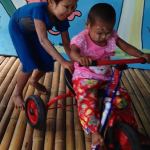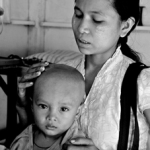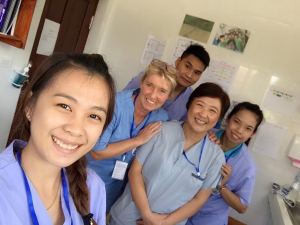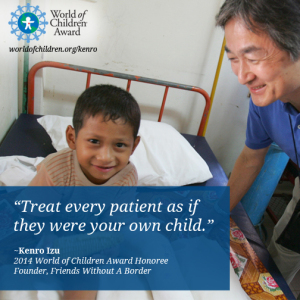A Different type of travel:
Why people are starting to travel this way. There is a ripple effect, people that go there are truly inspired by what they see, they want to help, and they see they can make a difference. They see the effort that is being made, the need that is so great and the philosophy behind it which is only to help where it is needed.
Corinne and Brad Jefferson travelled to Cambodia with their family. Brad tells a story of walking through the hospital with hundreds of kids needing care and he was moved to tears. “It seems unreal because in Canada we just don’t see that much of a gap between those who need care and those who can access it.”
He was forever moved when he witnessed little kids rowing themselves to school in little boats. “All of a sudden the mom in the minivan shepherding her kids to French, ballet and gymnastics seems to be more about our parent agenda and I had this thought that maybe are impoverishing our kids of their internal motivation. I mean, these kids, with literally nothing, they want to go to school so they have to figure out how to get there. There is a six year old girl with a baby under her arm and a water snake for a toy. I am not kidding you, there is no one to come get them or think about what else they might need.”
Medical services in a city of extremes -printed with permission of Mike Kear
Medical Action Myanmar provide vital medical services to some of the poorest suburbs on the outskirts of Yangon. Services range from sexual and reproductive health, HIV testing and treatment, to treatment of malaria and tuberculosis (TB), all packed into four small but very efficient and effective clinics. The original and largest clinic in Hlaing Tha Yar township, which has been operational since 1994 and originally set up by Médecins Sans Frontières (MSF), serves a population of about 400,000 people and they typically see 300 clients a day.
What struck me most was the many pragmatic and common sense approaches they took to looking at the patient in the broadest sense. The efficacy of treating HIV is restricted if the patient is lacking in basic nutrition, as is so often the case in clients who discover they are HIV positive at the clinic. The clinic has a feeding centre which provides a balanced diet for a six month period for malnourished children. The centre is a fun place for the children to play and be monitored, thereby making feeding a more positive experience. MAM also provide what is called “Dry Rations” to patients on ART or TB medication that have dietary needs.
Health care in Yangon is generally regarded as poor with less that 0.5% of national budget spent on it. Yangon is growing at a rapid rate and accommodation in downtown Yangon is some of the most expensive in SE Asia, partly as a result of supply not meeting the demand from foreigners working for NGO’s and large companies with the resulting knock on effect to locals. There is severe economic hardship in the suburbs surrounding Yangon that the clinics serve. MAM provide assistance with transport fees for some HIV  positive patients to ensure they can attend clinic regularly.child in for treatment.
positive patients to ensure they can attend clinic regularly.child in for treatment.
The clinic has an outreach programme to encourage sex workers to attend the clinic for regular screenings for STIs including HIV. This includes a dedicated waiting area which is comfortably set up with coffee and noodles are served. This makes for a positive experience for anyone attending and provides a space to relax, chill out and share time with each other. The aim is to “make it their home” so they visit regularly, ideally every month. They have a trained peer educator who used to be a sex worker and she overseas the outreach programme. This also includes making a payment to women who recruit new patients and bring them to the clinic.
The clinic provides TB services, but unfortunately the government won’t allow patients to stay over night as it is not a hospital, so all patients have to go home. MAM now has a separate patient house for those that have to travel a long way to the clinic.
 On the 27th January 2015 over 480 people collected in the Four Season Hotel Vancouver for the 6th annual wine tasting event. The vibrant crowd enjoyed wine tasting, a silent auction, raffle, live auction and learned more about how healthcare in South East Asia is supported from funds generated at this event. The atmosphere was pulsating as people mingled and enjoyed the evening events. In order to give thanks and encourage support a short address was given. Here is a synopsis.
On the 27th January 2015 over 480 people collected in the Four Season Hotel Vancouver for the 6th annual wine tasting event. The vibrant crowd enjoyed wine tasting, a silent auction, raffle, live auction and learned more about how healthcare in South East Asia is supported from funds generated at this event. The atmosphere was pulsating as people mingled and enjoyed the evening events. In order to give thanks and encourage support a short address was given. Here is a synopsis.
’Every year I am humbled by the incredible amount of hard work that goes into this event and the dedication and commitment of the co-chairs, committee, volunteers, sponsors and donors who make it all happen. Money raised here tonight goes directly to the projects on the ground. A donation of $5 will provide pain medication for 50 children in Cambodia. A donation of $50 will provide testing and treatment for malaria for 10 patients in Myanmar. Your support not only has the power to change lives, but also to save lives. ’
 On November 6, Kenro Izu will be honored in New York City with the 2014 World of Children Health Award at our annual Awards Ceremony along with 5 other extraordinary changemakers for children
On November 6, Kenro Izu will be honored in New York City with the 2014 World of Children Health Award at our annual Awards Ceremony along with 5 other extraordinary changemakers for children
Saving a Child’s Life. Kenro Izu is using his funding to construct a brand-new children’s hospital in Laos. He’s bringing the same strategy and efforts to this new hospital as the one he created in the 1990s that transformed pediatric healthcare in Cambodia.
In 1999, the Angkor Hospital for Children opened its doors. Subsequently, satellite clinics were opened as a model of locally sustainable healthcare.
Angkor Hospital for Children. Since then, his organization Friends Without A Border (FWAB) has treated over 1.2 million children and provided advanced training to thousands of health workers. On February 11, 2015, a similar state-of-the-art pediatric teaching hospital in Laos was completed an opened to the public. Funding from World of Children Award supports FWAB in constructing and equipping this new hospital (the Lao Friends Hospital for Children) in Laos.
March 2015 – World of Children Founders travel to Cambodia and to Laos Click here to watch the Video from visit to the Angkor Children’s Hospital in Siem Reap, Cambodia
In March 2015, Founders Harry and Kay Leibowitz traveled to Cambodia to visit the children served by Kenro’s hospitals. While Kenro was unable to join them, our Founders took a group of eager travelers with them to visit the Angkor Hospital for Children in Cambodia and the new Lao Friends Hospital for Children in Laos. “The number of children being served and families being saved is almost unbelievable for a small country like Cambodia. Benito’s team services hundreds of children every day in some 60 projects nationwide and Kenro’s one hospital in Siem Reap sees at least 500 children a day in a facility that is not even half the size of a standard US Hospital. The children all come into their programs challenged or ill, disenfranchised or injured, hopeless or frightened, but they all exit the programs smiling, with a great hope for the future and a full life ahead of them.”
At AHC the group was greeted by Helen Catton –
Kenro Izu didn’t know how to run a hospital. He didn’t have a medical degree. But he knew he had to stop the horrible tragedy that he had just witnessed from ever happening again.
“It was a decisive moment when I saw a young girl die in front of my eyes in the regional hospital,” Kenro said.
 Saving a Child’s Life. Kenro Izu is using his funding to construct a brand-new children’s hospital in Laos. He’s bringing the same strategy and efforts to this new hospital as the one he created in the 1990s that transformed pediatric healthcare in CambodiaEdddd
Saving a Child’s Life. Kenro Izu is using his funding to construct a brand-new children’s hospital in Laos. He’s bringing the same strategy and efforts to this new hospital as the one he created in the 1990s that transformed pediatric healthcare in CambodiaEdddd
 The amazing volunteer Angela Heim-Ehmer from Munich Germany…Angela with the pharmacy team at the Lao Friends Hospital for Children.
The amazing volunteer Angela Heim-Ehmer from Munich Germany…Angela with the pharmacy team at the Lao Friends Hospital for Children.
While she was here she also participated in running the 7km during the Luang Prabang half marathon which was a fundraiser for the hospital on Oct 18th, brought a bunch of needed donated medical supplies with her (all items that we have a lot of trouble finding locally), and will also be bringing back lots of LFHC pamphlets & photos with her to set up a fundraiser at her workplace in Germany. She is a real star!
“Hello, my name is Angela Heim-Ehmer, I come from Munich in Germany and worked as a volunteer in the pharmacy at the Lao Friend Hospital for Children since 4 weeks. We help the Laotian colleagues to develop the important standards for a hospital,support them in their daily work and work together to ensure a secure supply of children with medicine. I am very happy to be able to make a small contribution for children in and around Luang Prabang with my work at the Lao Friend Hospital for children.
I hope I will come back again! Many regards, Angela Heim-Ehmer”
 Having studied psychology, Helen initially worked in Japan for five years. She volunteered in South East Asia, seeing not only a great need for compassionate health care and education but also was struck by the imbalance of life that seems to be a roll of the dice. Helen believes that her privilege of being brought up with parents, opportunity, shelter and health care creates a responsibility for her to help those who were not as lucky to be born into what we consider basic human right.
Having studied psychology, Helen initially worked in Japan for five years. She volunteered in South East Asia, seeing not only a great need for compassionate health care and education but also was struck by the imbalance of life that seems to be a roll of the dice. Helen believes that her privilege of being brought up with parents, opportunity, shelter and health care creates a responsibility for her to help those who were not as lucky to be born into what we consider basic human right.
She returned to the UK and studied nursing and gained practical care giving experience working in a London hospital.
She took a nursing course in tropical diseases at the London School of Hygiene and Tropical Medicine, then worked on the Thai Burmese border for two years mostly helping the Burmese, Mon and Karen who had little access to health care.
In 2010 she went to Angkor Hospital for Children which is a pediatric teaching hospital in order to manage the Satellite Clinic from the ground located one hour from Siem Reap in Cambodia. .
She dove in and found herself to be the only foreigner in the town and a large cultural and linguistic barrier. Her assimilation into Cambodia rural culture was started by living “in a modest, umm, house, with no running water; yet it was replete with spiders, scorpions and rats. Despite the cold water bucket baths and basic living conditions, she stuck it out, and is now transitioning the leadership of Satellite to the senior Cambodian staff.
Helen recently came to Vancouver and was a sought after speaker at hospitals and private gatherings. She has power point presentations about the hospital, she collects appropriate medical supplies and even donations of knitted hats for neonates and premature babies. Helen is creating awareness and interest for a community that is in desperate need of help. It is the kind of help that seems easy to give. “When there is so little, just a few things go a long way.”
2015 St Paul’s ICU at UBC dental dept UBC ICU
FACTS:
Angkor Hospital for Children, founded by Kenro Izu, annual budget is actually 6 million dollars.
Taste The World fundraiser promotes awareness and donors and funds the most pressing needs at the hospital. Because it is not a restricted donation it can fill areas of greatest need in the hospital.
“If I have my health and energy and something to share I want to share that privilege to balance out that equation.”
“ “I feel extremely grateful to be able to do a job I am extremely passionate about. It is not just a job but a passion.”
Helen Catton spoke at the last two TTW events. She is British nurse who has worked in Asia for 12 years she heads up the satellite hospital for AHC and leads the Cambodian team to provide healthcare to rural population.
……a few words with World of Children Award Honouree Kenro Izu
Where do you see Friends Without A Border going in the next 10 years?
Friends’ main focus over the next 10 years will be on Lao Friends Hospital for Children and developing programs of Treatment + Education + Prevention, and to create a center for teaching pediatrics in Lao PDR. Our goal is to build LFHC as the major education center of pediatric health care and create a positive impact on health care for the whole country.
With LFHC, the goal is that all children who seek help will receive high-quality and compassionate care…it’s as I always tell our staff, “Treat every patient as if they were your own child.”
How will World of Children Award help you to expand your program?
It will help us spread awareness and put a spotlight on an area that has been much neglected. Very little attention has been paid to Southeast Asia, Laos and Cambodia especially. This is simply due to the fact that many people are in the dark about the struggles those communities face, and how desperate the health situation is. Having the backing of such a respected organization as World of Children Award will help us reach a wider audience and will bring more weight to the situation.
 Kenro Izu first encountered Cambodia’s appalling lack of pediatric healthcare when he met children suffering from a variety of disabilities and illnesses during a photography trip in 1993.
Kenro Izu first encountered Cambodia’s appalling lack of pediatric healthcare when he met children suffering from a variety of disabilities and illnesses during a photography trip in 1993.
Tragically, he witnessed a young girl die in front of his eyes in the regional hospital. Her life was cut short because her parents could not pay the $2 needed to treat her. The hospital and the doctors of the hospital left the girl alone without providing any treatment.
